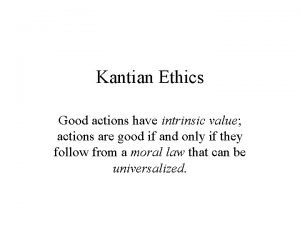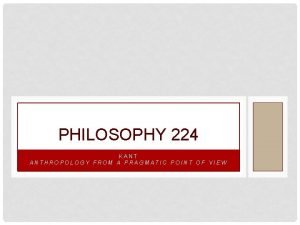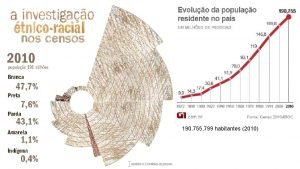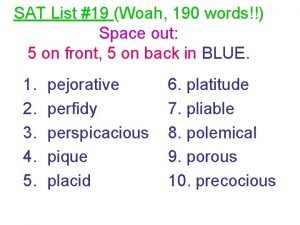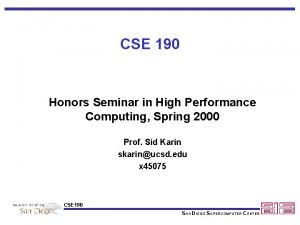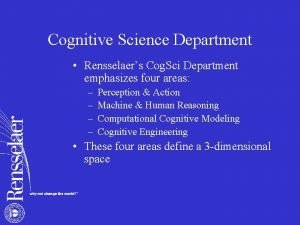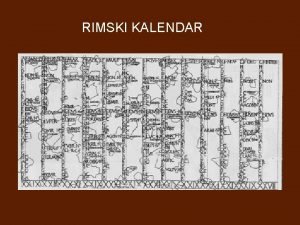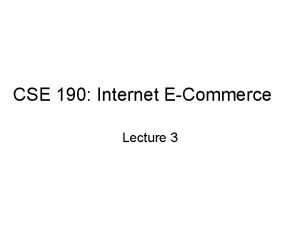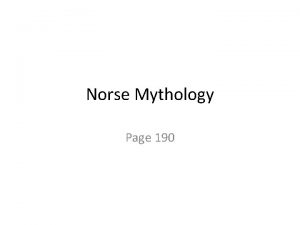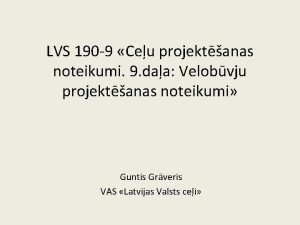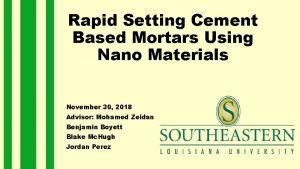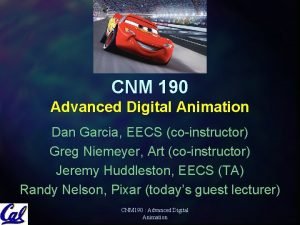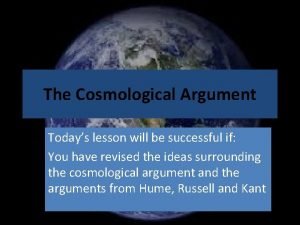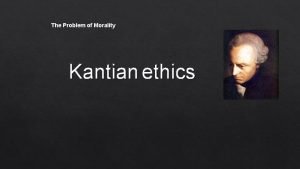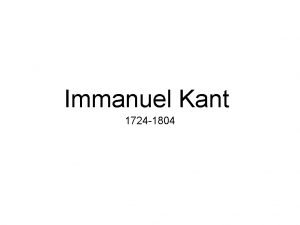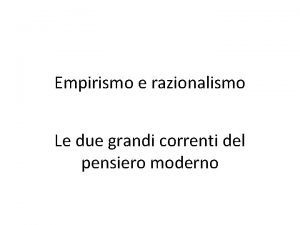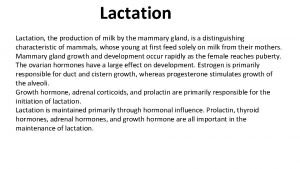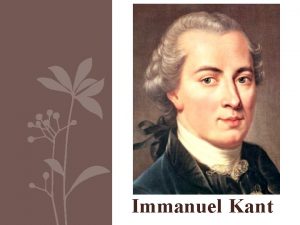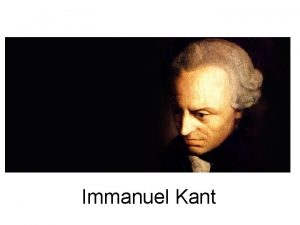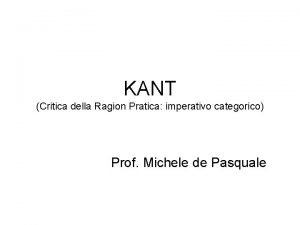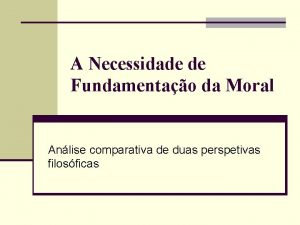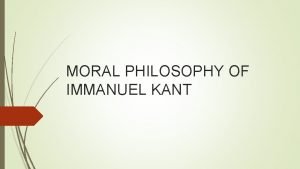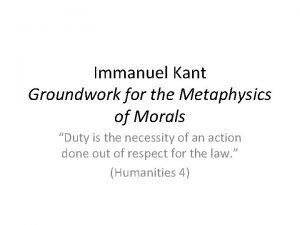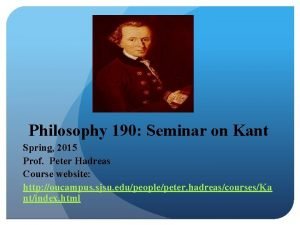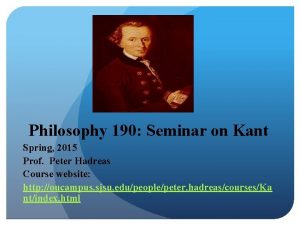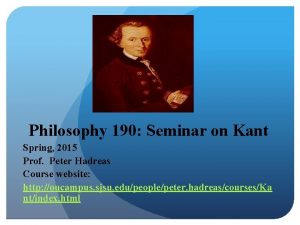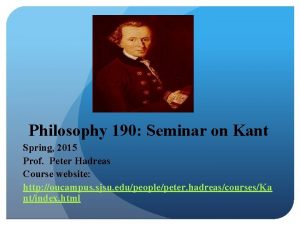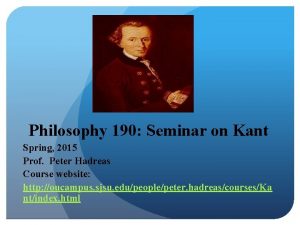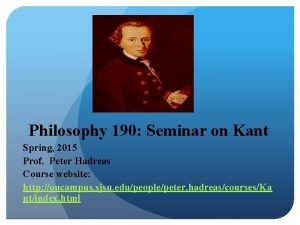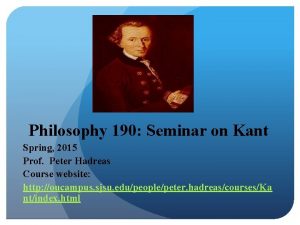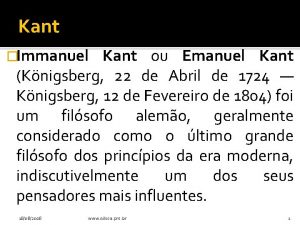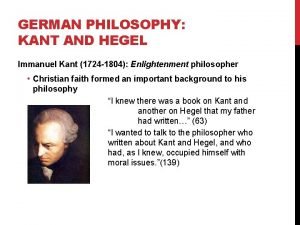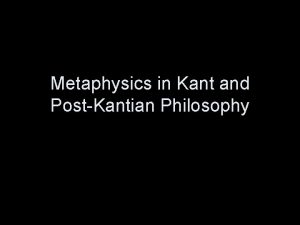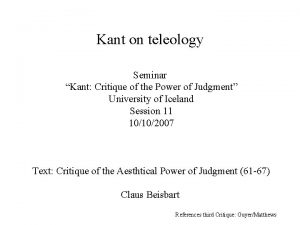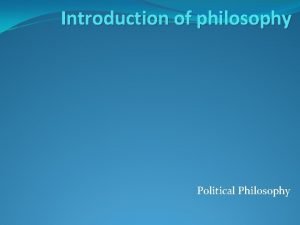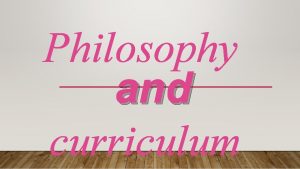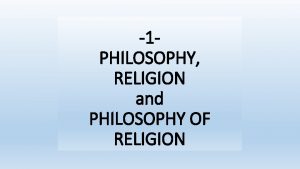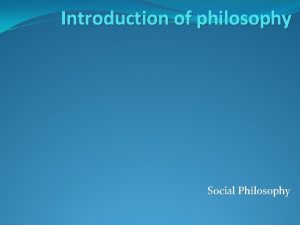Philosophy 190 Seminar on Kant Spring 2015 Prof




![KANT’S IDEAL OF REASON: Allen Wood’s Summary [continued from previous slide] “Of course, our KANT’S IDEAL OF REASON: Allen Wood’s Summary [continued from previous slide] “Of course, our](https://slidetodoc.com/presentation_image_h2/d702c17e1f564995ae438cc08f59013d/image-5.jpg)

![KANT’S IDEAL OF REASON Section One The ideal in general. [continued from previous slide] KANT’S IDEAL OF REASON Section One The ideal in general. [continued from previous slide]](https://slidetodoc.com/presentation_image_h2/d702c17e1f564995ae438cc08f59013d/image-7.jpg)




















![Chapter four: p. 576 [continued from previous slide] “But in my financial condition there Chapter four: p. 576 [continued from previous slide] “But in my financial condition there](https://slidetodoc.com/presentation_image_h2/d702c17e1f564995ae438cc08f59013d/image-28.jpg)










- Slides: 38

Philosophy 190: Seminar on Kant Spring, 2015 Prof. Peter Hadreas Course website: http: //oucampus. sjsu. edu/people/peter. hadreas/courses/Ka nt/index. html

“The Ideal of Pure Reason” pp. 551 -589.

Critique of Pure Reason Prefaces Introduction Transcenden tal Doctrine of Elements First Part Trans. Aesthetic Transcenden tal Method Second Part Trans. Logic Division One: Trans. Analytic Book I: Analytic of Concepts Book II: Analytic of Principles Introduction Chapter 1: The Paralogisms of Pure Reason Division Two: Trans. Dialectic Book I: Concepts of Pure Reason Chapter II: The Antinomy of Pure Reason Book II: The dialectical inferences of pure reason Chapter III: the Ideal of Pure Reason

KANT’S IDEAL OF REASON: Allen Wood’s Summary 1 “Again roughly stated, Kant's theory is that since the idea of a most perfect being includes in it every possible perfection or reality, the complete set of properties which might belong to any possible thing could (in theory) be determined by limiting or selecting from the properties of God in the right way. The idea of God therefore provides us with a (purely abstract) conception of "the material of all possibility, " of a source from which all the properties of any and every possible thing could in principle be derived. 1. Wood, Allen J. , Kant's Rational Theology (Ithaca and London: Cornell University Press, 1978), pp. 19 -20.
![KANTS IDEAL OF REASON Allen Woods Summary continued from previous slide Of course our KANT’S IDEAL OF REASON: Allen Wood’s Summary [continued from previous slide] “Of course, our](https://slidetodoc.com/presentation_image_h2/d702c17e1f564995ae438cc08f59013d/image-5.jpg)
KANT’S IDEAL OF REASON: Allen Wood’s Summary [continued from previous slide] “Of course, our finite reason has no access to any such source in the concrete, and our determination of the properties of things must proceed by the gradual accumulation of empirical knowledge, which will always fall far short of completeness. Yet we can be distinctly aware of our finitude in this respect only insofar as we have the capacity to form some conception (however vague and inadequate) of what the completion of our task might be like. Thus we quite naturally come upon the idea of a supreme being, in Kant's view, a being whose properties, if we could know them concretely, would enable us to accomplish a thorough determination of any other possible thing. ” 11. Wood, Allen J. , Kant's Rational Theology (Ithaca and London: Cornell University Press, 1978), pp. 19 -20.

KANT’S IDEAL OF REASON Section One The ideal in general. “We have seen above that no objects at all can be represented through pure concepts of the understanding without any conditions of sensibility, because the conditions for the objective reality of these concepts are lacking, and nothing is encountered in them except the pure form of thinking. Nevertheless they can be exhibited in concreto if one applies them to appearances; for in the latter they have the proper material for a concept of experience, which is nothing but a concept of the understanding in concreto. Ideas, however, are still more remote from objective reality than categories; for no appearance can be found in which they may be represented in concreto. (p. 551)
![KANTS IDEAL OF REASON Section One The ideal in general continued from previous slide KANT’S IDEAL OF REASON Section One The ideal in general. [continued from previous slide]](https://slidetodoc.com/presentation_image_h2/d702c17e1f564995ae438cc08f59013d/image-7.jpg)
KANT’S IDEAL OF REASON Section One The ideal in general. [continued from previous slide] “They contain a certain completeness that no possible empirical cognition ever achieves, and with them reason has a systematic unity only in the sense that the empirically possible unity seeks to approach it without ever completely reaching it. But something that seems to be even further removed from objective reality than the idea is what I call the ideal, by which I understand the idea not merely in concreto but in individuo, i. e. , as an individual thing which is determinable, or even determined, through the idea alone. (p. 551)

KANT’S IDEAL OF REASON Section Two: The transcendental ideal (Prototypon transcendentale) [In this section Kant Proposes a ‘transcendental theology] “Every concept, in regard to what is not contained in it, is indeterminate, and stands under the principle of determinability: that of every two contradictorily opposed predicates only one can apply to it, which rests on the principle of contradiction and hence is a merely logical principle, which abstracts from every content of cognition, and has in it nothing but the logical form of cognition. ” p. 553 NOTE: Kant here is simply pointing out that every concept must permit either a predicate or its contradiction and preserve truth logically speaking. So X is a capybara or it is not a capybara, a platypus or not a platypus, a resident of San José or not a resident of San Jose, etc.

KANT’S IDEAL OF REASON Section Two: The transcendental ideal (Prototypon transcendentale) [In this section Kant Proposes a ‘transcendental theology] “Every thing, however, as to its possibility, further stands under the principle of thoroughgoing determination; according to which, among all possible predicates of things, insofar as they are compared with their opposites, one must apply to it. ” (p. 553) NOTE: Kant here makes a first step towards a transcendental idea. He’s no longer talking about a logical principle, but a way in which each thing relates, via all possible contradictions to the ‘whole of possibility, ’ not as logical forms but as all possible things whatsoever.

KANT’S IDEAL OF REASON Section Two: The transcendental ideal (Prototypon transcendentale) [In this section Kant Proposes a ‘transcendental theology] “The proposition Everything existing is thoroughly determined signifies not only that of every given pair of opposed predicates, but also of every pair of possible predicates, one of them must always apply to it; through this proposition predicates are not merely compared logically with one another, but the thing itself is compared transcendentally with the sum total of all possible predicates. ” (p. 554) NOTE: Kant here explicitly states the connection to a transcendental idea. He moves toward the notion that each thing is grounded in the possibility of all things.

KANT’S IDEAL OF REASON Section Two: The transcendental ideal (Prototypon transcendentale) [In this section Kant Proposes a ‘transcendental theology] “Now although this idea of the sum total of all possibility, insofar as it grounds every thing as the condition of its thoroughgoing determination in regard to the predicates which may constitute thing, is itself still indeterminate, . . . we nevertheless find on closer investigation that this idea, as an original concept, excludes a multiplicity of predicates, which, as derived through others, are already given, Or cannot coexist with one another. . . and then must be called an ideal of pure reason ” (p. 554) NOTE: Kant now is moving from a transcendental Idea to a transcendental Ideal. ‘The sum total of possibility’ is going to have a certain character in that some possibilities will be redundant or cannot coexist, such as ‘healthy’ and ‘not sick’ and the possibility of being odd and the possibility of being even at once.

KANT’S IDEAL OF REASON Section Two: The transcendental ideal (Prototypon transcendentale) [In this section Kant Proposes a ‘transcendental theology] “If we consider all possible predicates not merely logically but transcendentally, i. e. , as to their content which can be thought in them a priori, then we find that through some of them a being is represented, and through others a mere non-being. ” (p. 554 -5) NOTE: Since the possibility of all predicates will include all that can possibly co-exist with each other, there is a set of predicates which apply to anything whatsoever. Kant calls the affirmation of the collection of things that can co-exist a ‘transcendental affirmation’ and the collection of things, ‘A Something, ’ ‘reality’ and ‘thinghood. ’ Accordingly he calls the negation of those that remain that cannot possibly of co-exist ‘transcendental negation, ’ and the collection of such non-entities ‘the removal of everything that is represented. ’ (p. 555)

KANT’S IDEAL OF REASON Section Two: The transcendental ideal (Prototypon transcendentale) [In this section Kant Proposes a ‘transcendental theology] “Thus if the thoroughgoing determination in our reason is grounded on a transcendental substratum, which contains as it were the entire storehouse of material from which all possible predicates of things can be taken, then this substratum is nothing other than the idea of an All of reality (omnitudo realitatis). All true negations are then nothing but limits, which they could not be called unless they were grounded in the unlimited (the All). ” (p. 555) NOTE: Kant furthers here the description of the transcendental affirmation as affirming all of reality. He further fills out that true negations, as impossibly existing things, are ‘limits’ and they are grounded in the ‘unlimited (the All). ’

KANT’S IDEAL OF REASON Section Two: The transcendental ideal (Prototypon transcendentale) [In this section Kant Proposes a ‘transcendental theology] “Through this possession of all reality, however, there is also represented the concept of a thing in itself which is thoroughly determined, and the concept of an ens realissimum is the concept of an individual being, because of all possible opposed predicates, one, namely that which belongs absolutely to being, is encountered in its determination. ” (p. 556) NOTE: Kant extends here the notion of limit to the ‘All’ or ‘unlimited’ arriving at a ‘most real’ individual being. This would involve the removal of limits on such notions as time, space, and all the Categories of Understanding, arriving at a singular Being which is unconditioned and complete. Of course this most real Being is beyond the capacities of understanding.

KANT’S IDEAL OF REASON Section Two: The transcendental ideal (Prototypon transcendentale) [In this section Kant Proposes a ‘transcendental theology] “The logical determination of a concept through reason rests on a disjunctive syllogism, in which the major premise contains a logical division (the division of the sphere of a general concept), the minor premise restricts this sphere to one part, and the conclusion determines the concept through this part. . . The use of reason through which it grounds its determination of all things in the transcendental ideal is, accordingly, analogous to its procedure in disjunctive syllogisms; that was the proposition on which I above grounded the systematic division of all transcendental ideas, according to which they were generated parallel and corresponding to the three kinds of syllogisms. ” (p. 556) NOTE: Kant fulfills his project of connecting the Transcendental Idea(l)s to the three types of syllogisms.

KANT’S IDEAL OF REASON Section Two: The transcendental ideal (Prototypon transcendentale) [In this section Kant Proposes a ‘transcendental theology] “Now if we pursue this idea of ours so far as to hypostatize it [that is make it into a substance], then we will be able to determine the original being through the mere concept of the highest reality as a being that is singular, a simple, all-sufficient, eternal, etc. , in a word, we will be able to determine it in its unconditioned completeness through all predications. The concept of such a being is that of God thought of in a transcendental sense, and thus the ideal of pure reason is the object of a transcendental theology, just as I have introduced it above. ” (p. 558) NOTE: So Kant arrives at God. What is critical is to see that he has done so as based in concepts of the Understanding successfully broadened by Reason beyond the proper limits of Understanding.

KANT’S IDEAL OF REASON Section Two: [Kant’s final remarks in this chapter, Kant implies that ‘theist’ as opposed to ‘deist’ beliefs in God are not the result ‘transcendental theology. ’ He also asserts speculative theology depends on an elemental falsification. “That we subsequently hypostatize this idea of the sum total of all reality, however, comes about because we dialectically transform the distributive unity of the use of the understanding in experience, into the collective unity of a whole of experience; and from this whole of appearance we think up an individual thing containing in itself all empirical reality, which then -- by means of the transcendental subreption 1 we have already thought -- is confused with the concept of a thing that stands at the summit of the possibility of all things, providing the real conditions for their thoroughgoing determination. *”(p. 559) 1. added emphasis is not in Guyer and Wood text.

KANT’S IDEAL OF REASON Section Two Kant’s own note to ‘subreption at p. 559 of CPR. *“This ideal of the supremely real being, even though it is a mere representation, is first realized, i. e. , made into an object, then hypostatized, and finally, as we will presently allege, through a natural progress of reason in the completion of unity, it is even personified; for the regulative unity of experience rests not on appearances themselves (of sensibility alone), but on the connection of its manifold by understanding (in one apperception); hence the unity of the highest reality and the thoroughgoing determinability (possibility) of all things seems to lie in a highest understanding, hence in an intelligence. ” (p. 559)

KANT’S IDEAL OF REASON Section Two NOTE: What is transcendental subreption? “In ID [Kant’s Inaugural Dissertation: “On the Form and Principles of the Sensible and Intelligible World” (1770)] Kant describes subreption as the fallacy of confusing what is sensible with what belong to the understanding. . The identification of the fallacy of subreption marked an important stage in the development of critical philosophy, although the term itself is rarely used in CPR (see exceptionally A 643/ B 671). ” 1 1. Caygill, Howard, A Kant Dictionary, (Oxford: Blackwell, 1995), pp. 380 -1

KANT’S IDEAL OF REASON Section Two ADDITIONAL NOTE: What is transcendental subreption? Subreption. Lat. subreptio), According to Catholic Encyclopedia 1 “In canon law the concealment or suppression of statements or facts that according to law or usage should be expressed in an application or petition for a rescript. In its effects subreption is equivalent to obreption (q. v. ), which consists in a positive allegation of what is false. Subreption may be intentional and malicious, or attributable solely to ignorance or inadvertence. It may affect the primary, substantial reason or motive of the grant, or constitute merely a secondary or impellent cause of the concession. For the effect of subreption on the validity of grants see Rescripts. ” 1. “Subreption”, Meehan, Andrew B. , in the Catholic Encyclopedia (1913) Volume 14.

KANT’S IDEAL OF REASON Chapter Three, Section Three The grounds of proof of speculative reason for inferring the existence of a highest being. There are only three kinds of proof for the existence of God possible from speculative reason. ”All paths on which one may set forth with this aim either begin from determinate experience and the special constitution of our world of sense known a through it, and ascend from that by means of laws of causality to the highest cause outside the world; or else they are empirically grounded on an experience that is only indeterminate, i. e. , on some existence; or, finally, they abstract from all experience and infer the existence of a highest cause entirely a priori from mere concepts. The first proof is the physico-theological, the second the cosmological, and the third the ontological proof. There are no more of them, and there also cannot be any more. ” (p. 563)

Carmel Weiler on Kant’s Refutation of the Ontological, Cosmological and Physico-Theological Proof for the Existence of God

Ontological Proof Cosmological Proof Physico-theological Proof Kant’s Introduction to the Proofs Page 563 (B 619) Abstraction from all experience and inference of the existence of a highest cause entirely a priori from mere concepts. Empirically grounded that is only indeterminate, i. e. , on some existence Laws of causality to the highest cause outside the world. Summary from Sebastian Gardner (pp. 328 -329) Based on a priori concepts, by means of which alone theologian infers the existence of the highest being Based on “indeterminate experience” or experience in general, of things as existing contingently, from which the existence of an absolutely necessary being is inferred Based on “determinate experience”, of the world as having an orderly constitution, which is held to establish the existence of an author of nature Philosopher “der Gegner” Rene Descartes Leibniz - a contingentia mundi Type of Judgment Analytic Empirical

Ontological Proof Cosmological Proof Physico-theological Proof “God exists” – tries to establish the existence of the highest being on the basis of what is contained in the concept of God. If anything at all, e. g. myself, exists, then an absolutely necessary being exists; therefore God exists. (A 6046/B 632 -4, A 584/B 612) Laws of causality to the highest cause outside the world. Clarification Distinguishing between logical and real predicates Existence is not a real predicate Major premise: inference from experience in general to existence of something necessary Minor premise: contains an experience Based on “determinate experience”, of the world as having an orderly constitution, which is held to establish the existence of an author of nature Life Examples Triangle to establish “absolutely necessary” (A 594/B 622) Concept of eternity as understood in poetry (A 613/B 641) The world as understood in nature, and sublimity “architect of the world” (A 627/B 655) Forces of nature Financial condition of a hundred actual dollars (A 599/B 627)

Ontological Argument The real meaning of existence or distinguishing between real and logical predicates “Anything one likes can serve as a logical predicate, even the subject can be predicated of itself; for logic abstracts from every content. But the determination is a predicate, which goes beyond the concept of the subject and enlarges it. Thus it must not be included in it already. Being is obviously not a real predicate, i. e. , a concept of something that could add to the concept of a thing. It is merely the positing" of a thing or of certain determinations in themselves. In the logical use it is merely the copula of a judgment. The proposition God is omnipotent contains two concepts that have their objects: God and omnipotence; the little word "is" is not a predicate in it, but only that which posits the predicate in relation to the subject.

Now if I take the subject (God) together with all his predicates (among which omnipotence belongs), and say God is, or there is a God, then I add no new predicate to the concept of God, but only posit the subject in itself with all its predicates, and indeed posit the object in relation to my concept. Both must contain exactly the same, and hence when I think this object as given absolutely (through the expression, "it is"), nothing is thereby added to the concept, which expresses merely its possibility. Thus the actual contains nothing more than the merely possible. ” (A 596 -9/B 624 -7)

Chapter four: p. 576 “A hundred actual dollars do not contain the least bit more than a hundred possible ones. For since the latter signifies the concept and the former its object and its positing in itself, then, in case the former contained more than the latter, my concept would not express the entire object and thus would not be the suitable concept of it. ”
![Chapter four p 576 continued from previous slide But in my financial condition there Chapter four: p. 576 [continued from previous slide] “But in my financial condition there](https://slidetodoc.com/presentation_image_h2/d702c17e1f564995ae438cc08f59013d/image-28.jpg)
Chapter four: p. 576 [continued from previous slide] “But in my financial condition there is more with a hundred actual dollars than with the mere concept of them (i. e. , their possibility). For with actuality the object is not merely included in my concept analytically, but adds synthetically to my concept (which is a determination of my state); yet the hundred dollars themselves that I am thinking of are not in the least increased through this being outside my concept. (p. 567)

“The physico-theological proof of the existence of a single original being as the highest being is grounded on the cosmological, and the latter on the ontological; and since besides these paths no more are open to speculative reason, the ontological proof from pure concepts of reason is the only possible one – if even one proof of a proposition elevated so sublimely above empirical use of the understanding is possible at all. ” (A 630/B 658 Physicotheological Cosmologica l Ontological

Ontological proofs of the existence of God “In more recent times, Kurt Gödel, Charles Hartshorne, Norman Malcolm and Alvin Plantinga have all presented muchdiscussed ontological arguments which bear interesting connections to the earlier arguments of St. Anselm, Descartes and Leibniz. Of these, the most interesting are those of Gödel and Plantinga; in these cases, however, it is unclear whether we should really say that these authors claim that the arguments are proofs of the existence of God. ” 1 1. Oppy, Graham, "Ontological Arguments", The Stanford Encyclopedia of Philosophy (Spring 2015 Edition), Edward N. Zalta (ed. ), URL = <http: //plato. stanford. edu/archives/spr 2015/entries/ontological-arguments/>.

Ontological proofs of the existence of God: Sketch of Plantinga’s Argument 1 Alvin Plantinga proposes a possible worlds analysis of the question. A possible worlds is any world which is logically consistent. Plantinga follows the standard possible world analysis of ‘possible’ ‘actual’ and ‘necessary. ’ If some state of affairs is possible then there is an actual possible world in which it takes place. If some state of affairs is necessary then it takes place in all possible worlds. But it is possible that God exists; hence, there is a possible world in which God exists. But God by definition is a necessary being. Therefore Gods exists in all possible worlds. If God exists in all possible world then God exists in this one. 1"Evolution, Shibboleths, and Philosophers". The Chronicle of Higher Education. April 11, 2010. Retrieved 2010 -04 -28. Like any Christian (and indeed any theist), I believe that the world has been created by God, and hence "intelligently designed. ” See also Plantinga, A. , 1967, God and Other Minds, Ithaca: Cornell University Press.

Ontological proofs of the existence of God: Outline of Gödel's proof 1 Gödel argued that in some possible world there exists God. He did not assume God’s existence in a possible world but rather arrive at this inference from the notion of a ‘positive property’ which necessarily entails positive properties. He then argues that the notion of ‘positive property’ is logically consistent with Godlikeness, as the conjunction of infinitely many positive properties. Gödel then defines essences: “if x is an object in some world, then the property P is said to be an essence of x if P(x) is true in that world and if P entails all other properties that x has in that world. ” Also, x necessarily exists if for every essence P the following is true: in every possible world, there is an element y with P(y).

Ontological proofs of the existence of God: Outline of Gödel's proof 1 “Gödel continues that necessary existence is positive, so it must follow from Godlikeness. Moreover, Godlikeness is an essence of God, since it entails all positive properties. Since it has been established that any Godlike object is necessarily existent, it follows that any Godlike object in one world is a Godlike object in all worlds. (Gödel like Plantinga assumes the modal logic axiom that necessary existence implies existence in all possible worlds. ) So, if the existence of a Godlike object is in one world, there is a Godlike object in every possible world.

Ontological proofs of the existence of God: Outline of Gödel's proof 1 “If one adds to Gödel's proof 1 Leibniz's law, the identity of indiscernibles, that is two or more objects are identical (are one and the same) if they have all their properties in common, there would only be one object in each world that possesses property all positive properties. But Gödel in fact did not make this move. He limited his proof to the issue of existence, leaving out uniqueness. ” 1. The official textual source for Gödel’s proof is Kurt Gödel (1995). "Ontological Proof". Collected Works: Unpublished Essays & Lectures, Volume III. pp. 403– 404. Oxford University Press. ISBN 0 -19 -514722 -7 2. But in all honesty, the Wikipedia Article, “Gödel's ontological proof” seems very comprehensive and instructive in this case: URL: http: //en. wikipedia. org/wiki/G%C 3%B 6 del%27 s_ontological_proof#cite_not e-8

KANT’S IDEAL OF REASON Section Seven: Critique of all theology from speculative principles on reason. “If by "theology" I understand the cognition of the original being, then it is either from pure reason (theologia rationalis) or from revelation (revelata). Now the first of these thinks its object either merely through pure reason, by means of sheer transcendental concepts (as an ens originarium, realissimum, ens entium) and is called transcendental theology, or else through a concept which it borrows from nature (the nature of our soul) as the highest intelligence, and would have to be called natural theology. Someone who admits only a transcendental theology would be called a deist; but if he also accepts a a natural theology, he would be called a theist.

KANT’S IDEAL OF REASON Section Seven: Critique of all theology from speculative principles on reason. “Now I assert that all attempts of a merely speculative use of reason in regard to theology are entirely fruitless and by their internal constitution null and nugatory, but that the principles of reason's natural use do not lead at all to any theology; and consequently, if one did not ground it on moral laws or use them as guides, there could be no theology of reason at all. For all synthetic principles of understanding are of immanent use; but for the cognition of a highest being a transcendent use of them would be required, for which our understanding is not equipped at all. ” [continued on following slide]

KANT’S IDEAL OF REASON Section Seven: Critique of all theology from speculative principles on reason. “If the empirically valid law of causality is to lead to an original being, then this would have to belong to the causal chain in objects of experience; but then it, like all appearances, would have to be are allowed to make good this lack of complete determination by means of a mere idea of the highest perfection and original necessity, then we could be permitted this only by special favor, but it cannot be demanded by the right of an irresistible proof. Thus the physico-theological proof could perhaps lend support to other proofs (if there were any), by connecting speculation with intuition; but by itself it is more a preparation of the understanding for theological cognition, providing it with a straight and natural direction toward such cognition; it cannot complete the business alone. ” (p. 586 -7)

Slides #1 seriatim, Portrait of Immanuel Kant in mid-life: http: //www. lancaster. ac. uk/users/philosophy/courses/100/Kant 003. jpg
 Rule utilitarianism
Rule utilitarianism Kant theory
Kant theory Immanuel kant philosophical view of self
Immanuel kant philosophical view of self Spring break 2015
Spring break 2015 Spring summer fall winter and spring cast
Spring summer fall winter and spring cast Summer winter autumn spring months
Summer winter autumn spring months A girl pushes her little brother on his sled
A girl pushes her little brother on his sled S=bilangan asli
S=bilangan asli 10 % de 190 755 799
10 % de 190 755 799 190 words
190 words Cse 190
Cse 190 Dr kals
Dr kals Me 190 sjsu
Me 190 sjsu Vertical mill tooling
Vertical mill tooling Da 2823
Da 2823 Cogsci 190
Cogsci 190 Rimski broj d
Rimski broj d Cse 190
Cse 190 Norse blind god
Norse blind god Doti
Doti Adva 190
Adva 190 Cnm 190
Cnm 190 190 vauxhall bridge road mental health
190 vauxhall bridge road mental health Lion poids 130 kg
Lion poids 130 kg Kant's criticism of cosmological argument
Kant's criticism of cosmological argument Maximas kantianas
Maximas kantianas Kant first categorical imperative
Kant first categorical imperative Noumeno kant
Noumeno kant Agis de telle sorte que tu traites l'humanité
Agis de telle sorte que tu traites l'humanité Kant ideias
Kant ideias Empirismo e razionalismo kant
Empirismo e razionalismo kant Kow kant kick
Kow kant kick Immanuel kant
Immanuel kant Sapere aude kant
Sapere aude kant Antistoricismo illuministico
Antistoricismo illuministico Critica della ragion pratica schema
Critica della ragion pratica schema Kant revolução francesa
Kant revolução francesa Immanuel kant teori
Immanuel kant teori Categorical imperative
Categorical imperative

